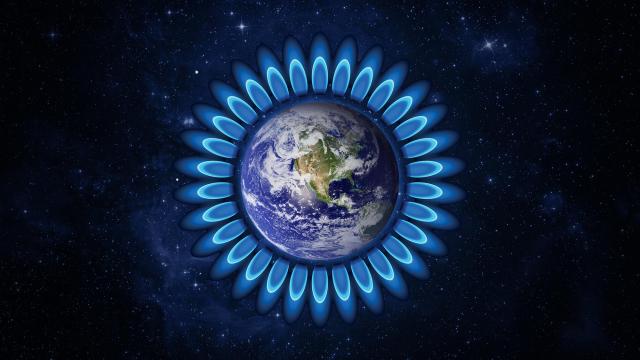
(Source: HartEnergy.com; flight of imagination, buradaki/Shutterstock.com)
Global natural gas consumption suffered a record decline but proved resilient in 2020, rebounding strongly in the second half of the year and outperforming other fuel sources, the International Energy Agency (IEA) said in its quarterly gas report.
The world’s annual consumption fell by about 100 Bcm in 2020, a 2.5% decline that roughly matches the annual consumption of Japan. What kept the market somewhat buoyant compared to oil (drop of 8% to 9%) and coal (drop of about 5%) was LNG’s growth of about 2%. LNG had risen 10% year-on-year on a regular basis but its diminished level of growth was still a positive in a very uncertain environment, Jean-Baptiste Dubreuil, senior natural gas analyst for the IEA, said during a recent webinar hosted by Rice University’s Baker Institute of Public Policy.
“Gas benefited from the low-price environment that enabled further fuel switching in power generation,” Dubreuil said. The shift was most visible example in the U.S. where the abundance of cheap natural gas helped to depress coal generation in spite of an overall decline in electricity consumption.
The IEA estimated that U.S. gas consumption for power generation increased by about 3% last year, while electricity demand decreased by 2%. By contrast, U.S. coal usage declined by almost 20%. Those trends were seen elsewhere, such as in Europe, but were not as pronounced because coal’s market position was much more dominant than it was in the U.S.
Global Demand
The 4% annualized demand drop in the first six months was a stress test for the global gas market across the value chain, forcing flexibility mechanisms along the chain to adjust, said IEA energy analyst Gergely Molnar. In the short term, it was pipelined supplies that endured the brunt of the pain.
The long-distance pipeline trade shrunk by 15%, or 40 Bcm, in the first three quarters of 2020. In Europe alone, gas pipelined in from Russia and North Africa fell by 22% in the first five months.
“It is important to note that almost 70% of the production decline occurred outside the United States,” Molnar said. In the fourth quarter, colder winter temperatures and recovering gas demand in Europe and Asia allowed the global gas trade to return to positive growth territory, albeit at an anemic 2%.
The plunge in gas demand was matched by gas prices in the first half of the year. Prices rallied strongly in the third quarter and by the fourth quarter were above 2019 levels. In Asia, spot prices for LNG had tumbled to a historic low of $2 per million British thermal units (MMBtu) in May, only to skyrocket to $30/MMBtu by January 2021. In Europe, fourth-quarter prices jumped to 25% over 2019 prices as more LNG was diverted to the Asian market. European prices in January averaged $10/MMBtu, their highest level in 29 months.
Recovery
“We do expect natural gas demand to increase by 2.8% this year or about 110 Bcm, which really mainly offsets the impact of last year, but not much more than that,” Dubreuil said. The pandemic recovery, he stressed, will not replicate recovery from the Great Recession in 2009-2010, when global gas demand increased by almost 8% year-on-year.
The recovery will be progressive, he said, and somewhat shrouded in uncertainty. Also, it will be experienced at different paces in different regions. Most of the gas consumption declines from 2019 to 2020 happened in the mature markets of North America, Europe and Eurasia. The recovery, however, will be led by emerging markets in Asia and, to a lesser extent, in India.
By year-end 2021, Dubreuil said, it is unlikely that mature markets in the Northern Hemisphere have recovered to pre-crisis levels. IEA expects demand growth of 2.8% this year, slightly above the 2020 decline.
However, slow growth in electricity demand will likely temper growth in gas-fired power generation. Industrial gas consumption is dependent on the economic recovery, particularly for export-driven industries in Asia. The economic recovery will be tied to the speed that the COVID-19 pandemic is brought under control.
Those factors do not take the weather into account.
“Residential demand received support from cold temperatures so far,” the IEA said in its report, “but would be negatively impacted in case of a return to milder weather conditions.”
Editor’s note: This story was originally published at 9 a.m. CT Feb. 2, 2021.
Recommended Reading
GA Drilling Moves Deep Geothermal Tech Closer to Commercialization
2025-02-19 - The U.S. Department of Energy estimates the next generation of geothermal projects could provide some 90 gigawatts in the U.S. by 2050.
E&Ps’ Subsurface Wizardry Transforming Geothermal, Lithium, Hydrogen
2025-02-12 - Exploration, drilling and other synergies have brought together the worlds of subsurface oil drilling and renewable energies.
Oil & Gas, Geothermal Technology Transfer Not a One-Way Street
2025-03-19 - Technologies commonly used in oil and gas are making it cheaper to drill deep into hot reservoirs to generate geothermal power, but the oil sector could also learn from geothermal, panelists say.
Google, SLB, Project Innerspace Form Geothermal Partnership
2025-03-06 - The geothermal partnership between Google Cloud, SLB and Project Innerspace takes shape as energy demand surges, driven in the U.S. by data center growth, the rise of electrification and an increase in manufacturing activity.
Energy Transition in Motion (Week of Feb. 14, 2025)
2025-02-14 - Here is a look at some of this week’s renewable energy news, including a geothermal drilling partnership.
Comments
Add new comment
This conversation is moderated according to Hart Energy community rules. Please read the rules before joining the discussion. If you’re experiencing any technical problems, please contact our customer care team.






